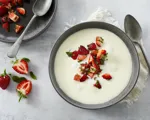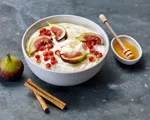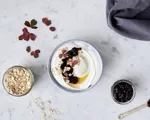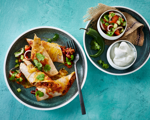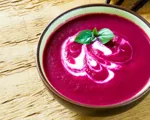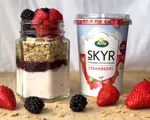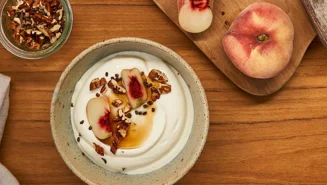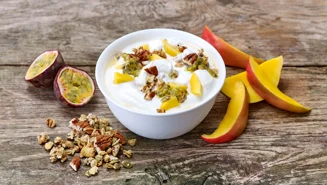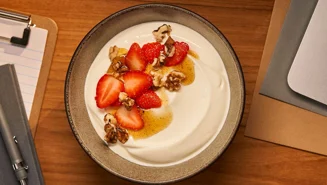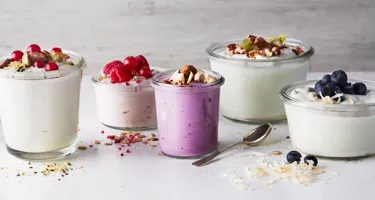
Quark is a type of fresh cheese with a firm, creamy texture and a fresh, tangy taste reminiscent of yogurt although milder and dryer. It can be used in several types of warm and cold dishes, making it a versatile and fun ingredient to incorporate into your everyday cooking and baking.
The production process involves a milk base being curdled by adding acid producing lactic bacteria to it. By doing that, the proteins in the milk start to coagulate and form curds. After the curdling process, the formed curds are strained, and when all the whey has been discarded, the remaining curds are what we call quark.
The product is particularly popular in Germany, Austria, and Switzerland, but it has seen a surge in popularity internationally because of its great taste and versatility in the kitchen.
What is quark made of?
Though it may be produced in different ways, quark is usually made of cow's milk – typically high pasteurised skimmed milk. While the type of milk does have some effect on the flavour, it is primarily decided by whichever lactic bacteria is used to curdle the milk, that is, turning it from liquid to solid.
Can you freeze quark?
Yes, you can freeze quark. Do it to extend the shelf life or to create a delicious dessert. Frozen quark is an excellent substitute for traditional ice cream. Freeze it as it is and enjoy it with garnish such as chopped chocolate, fresh berries, or caramel sauce, or mix it with blended fruits or berries before freezing it to incorporate your favourite flavours into the frozen treat. You can do the same with frozen skyr.
Freezing quark may alter the flavour and texture, but you can take some precautions. Store it – alone or mixed with fruit purée or the like – in an airtight container or a freezer-safe bag. Make sure to leave some room for the product to expand as changes in temperature will affect the texture.
If you freeze the quark to extend its shelf life, thaw it overnight in the refrigerator and whisk it once it has thawed to reach the right consistency again.
What is quark used for?
Thanks to its tangy flavour and creamy texture, quark pairs easily with both sweet and savoury dishes. Try it in anything from spreads, dressings, and dips to pancakes, baked goods, and desserts. You might find that it is particularly good in baked goods because it forms a strong gluten network in the dough, which helps retain air, resulting in a light and airy crumb.

Line up a delicious selection of bread and crackers and serve it with a quark-based spread or dip. Try, for instance, a smoky chipotle dip with lime juice, cumin, paprika, salt, and, of course, chipotle peppers in adobo sauce. The creamy, tangy quark flavour goes well with the heat. An herb and garlic spread with parsley, dill, chives, or basil can also lift any afternoon snack to a higher level.

You can also make a quark-based salad dressing. Try a creamy Caesar dressing with grated Parmesan cheese, minced garlic, lemon juice, mustard, Worcestershire sauce, and salt and pepper.
For baking and desserts, quark fits perfectly as a filling or as part of the batter. Pancakes, for example, benefit from the creaminess and tanginess, and it can be easily incorporated into the batter as well as served as topping with a bit of honey drizzled on top.
The possibilities are endless. Just remember to mix the quark with flour, when you use it in warm dishes, to avoid that it curdles.
There are various other dairy options to use as alternatives in cooking. Find inspiration in our articles Can you cook with skyr?, What is Greek yogurt?, and Different types of yogurt.
What does quark taste like?
Quark has a mild, tangy flavour similar to that of yogurt or crème fraiche. There are different types with some having a milder flavour and some having a stronger one. Nevertheless, the tangy flavour profile makes it a perfect food to complement sweet and savoury meals and snacks.
Its flavour profile can also vary depending on the type of acid used in the curdling process. Lemon juice will add a citrusy and tangy flavour, while vinegar will result in slightly more sharpness. Buttermilk is already fermented and will imbue the quark with a milder tang and a somewhat creamy flavour. No matter what, the result will be rife with a fresh, tangy flavour and a smooth, creamy consistency.
In many supermarkets, you can find plain quark as well as flavoured ones. As mentioned previously, you can also add flavour yourself by mixing quark natural with pureed fruits or berries.
What is the difference between quark and yogurt or skyr?
The main difference between quark and both yogurt and skyr is the flavour. The tanginess of quark is usually more subtle than yogurt, and the flavours are generally milder. Though quark is similar to skyr, it has a different taste as it is made using different bacterial cultures.
There are also differences in texture with yogurt having a thicker and more spoonable consistency, whereas quark is known for its smooth and creamy texture akin to Greek-style yogurt or cottage cheese. The consistency of quark is also slightly firmer than skyr, as it contains more dry matter. Read more in our quark vs skyr article.





